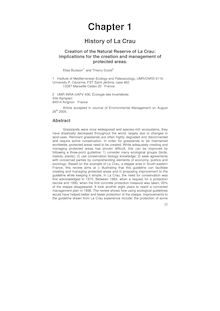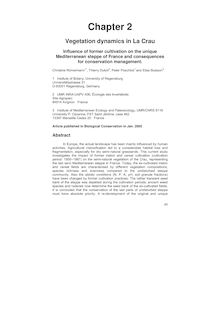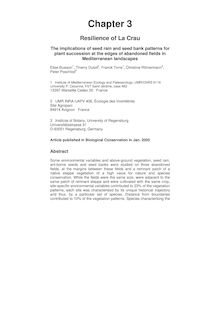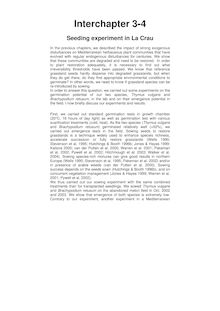-
 Univers
Univers
-
 Ebooks
Ebooks
-
 Livres audio
Livres audio
-
 Presse
Presse
-
 Podcasts
Podcasts
-
 BD
BD
-
 Documents
Documents
-
- Cours
- Révisions
- Ressources pédagogiques
- Sciences de l’éducation
- Manuels scolaires
- Langues
- Travaux de classe
- Annales de BEP
- Etudes supérieures
- Maternelle et primaire
- Fiches de lecture
- Orientation scolaire
- Méthodologie
- Corrigés de devoir
- Annales d’examens et concours
- Annales du bac
- Annales du brevet
- Rapports de stage
La lecture à portée de main
17 pages
English
Le téléchargement nécessite un accès à la bibliothèque YouScribe
Tout savoir sur nos offres
Tout savoir sur nos offres
17 pages
English
Le téléchargement nécessite un accès à la bibliothèque YouScribe
Tout savoir sur nos offres
Tout savoir sur nos offres

Description
Chapter 3 Resilience of La Crau The implications of seed rain and seed bank patterns for plant succession at the edges of abandoned fields in Mediterranean landscapes 1 2 1 3Elise Buisson , Thierry Dutoit , Franck Torre , Christine Römermann , 3Peter Poschlod 1 Institute of Mediterranean Ecology and Paleoecology, UMR/CNRS 6116 University P. Cézanne, FST Saint Jérôme, case 462 13397 Marseille Cedex 20 France 2 UMR INRA-UAPV 406, Écologie des Invertébrés Site Agroparc 84914 Avignon France 3 Institute of Botany, University of Regensburg Universitätsstrasse 31 D-93051 Regensburg, Germany Article published in Biological Conservation in Jan. 2005. Abstract Some environmental variables and above-ground vegetation, seed rain, ant-borne seeds and seed banks were studied on three abandoned fields, at the margins between these fields and a remnant patch of a native steppe vegetation of a high value for nature and species conservation. While the fields were the same size, were adjacent to the same patch of remnant steppe and were cultivated with the same crop, site-specific environmental variables contributed to 23% of the vegetation patterns; each site was characterised by its unique historical trajectory and thus, by a particular set of species. Distance from boundaries contributed to 10% of the vegetation patterns. Species characterising the surrounding steppe were found close to boundaries; species characterising abandoned fields were ...
Informations
| Publié par | Thuwyug |
| Nombre de lectures | 41 |
| Langue | English |
Extrait
Chapter 3
Resilience of La Crau The implications of seed rain and seed bank patterns for plant succession at the edges of abandoned fields in Mediterranean landscapes Elise Buisson 1 , Thierry Dutoit 2 , Franck Torre 1 , Christine Römermann 3 , Peter Poschlod 3
1 Institute of Mediterranean Ecology and Paleoecology, UMR/CNRS 6116 University P. Cézanne, FST Saint Jérôme, case 462 13397 Marseille Cedex 20 France
2 UMR INRA-UAPV 406, Écologie des Invertébrés Site Agroparc 84914 Avignon France
3 Institute of Botany, University of Regensburg Universitätsstrasse 31 D-93051 Regensburg, Germany
Article published in Biological Conservation in Jan. 2005 .
Abstract Some environmental variables and above-ground vegetation, seed rain, ant-borne seeds and seed banks were studied on three abandoned fields, at the margins between these fields and a remnant patch of a native steppe vegetation of a high value for nature and species conservation. While the fields were the same size, were adjacent to the same patch of remnant steppe and were cultivated with the same crop, site-specific environmental variables contributed to 23% of the vegetation patterns; each site was characterised by its unique historical trajectory and thus, by a particular set of species. Distance from boundaries contributed to 10% of the vegetation patterns. Species characterising the
surrounding steppe were found close to boundaries; species characterising abandoned fields were found further away. Winter seed banks and summer deep seed bank did not contribute much to either effect and were characterised by species dating back from past cultivation. Conversely, summer surface seed bank greatly contributed to (83%) the differences in species composition between the three fields. Seed rain contributed to differences in species composition between fields (91%) and distance (76%). Ant-borne seeds largely contributed to the differences between fields (87%). The colonisation of steppe species on field margins occurs mainly through seed rain and is very slow and incomplete. In a semi-arid fragmented open-landscape, patches of native vegetation do not play a great role in colonisation processes, and itinerant sheep grazing is insufficient to initiate recovery.
Keywords : ants; dry grassland; mosaic of herbaceous communities; seed bank; seed rain; steppe
Introduction While many studies on grazing, mowing and burning regimes have been carried out to plan conservation management for individual grasslands (Hillier et al., 1990; Poschlod and WallisDeVries, 2002), only few studies plan for long-term management within fragmented open-landscapes and studies on secondary succession and edges have yet to be relevant to long-term management. Studies focusing on edges assessed either the influence of agriculture-related factors on field-margin vegetation (Kleijn et al., 1997) or the influence of field-margin vegetation on crops (Dutoit et al., 1999; Von Arx et al., 2002). Investigating colonisation processes at edges of abandoned fields is important (Wilson and Aebischer, 1995) because the field potential to recover via long-term seed bank or long-distance seed rain has often been found to be relatively low in Northern Europe (Graham and Hutchings, 1988; Hutchings and Booth, 1996a; Kalamees and Zobel, 2002). Studying edges is even more important in dry climates, where drought induces conditions that dramatically slow down successional processes (Blondel and Aronson, 1999). Results may have important conservation implications, particularly in the Mediterranean basin where grasslands harbour a high proportion of endangered taxa (Médail and Quézel, 1999).
The hypothesis of this research was that remnant patches of vegetation are a source of seeds for the colonisation of abandoned fields either by
seed rain or ant dispersal. The aims of the present study were (1) to describe the colonisation processes on abandoned field margins over a complete growing season in order to determine how steppe vegetation re-establishes at the margins between abandoned fields and a remnant patch of steppe in order (2) to provide information for the long-term management of abandoned fields.

Methods Study area The study was carried out in the plain of La Crau, located ~50 km north-west of Marseille in south-eastern France. The steppe vegetation of the plain evolved with: 1) a dry Mediterranean climate; 2) a shallow soil (<400 mm) and an impermeable bedrock; 3) itinerant sheep grazing since 3000 BP (Buisson and Dutoit, 2004). The steppe vegetation is dominated by the stress-tolerant species Brachypodium retusum and Thymus vulgaris , which represent ~50% of the biomass, and is composed of a great diversity of annual species (Buisson and Dutoit, in press). The remnant central patch of steppe was fragmented by r ow crop and melon cultivations between 1965 and 1985, after which all patches of steppe and fields were grazed by itinerant sheep from February to June. Three abandoned fields (A, B, C) were selected on the sheepfold of Peau de Meau (43°33’E 4°50’N, elevation 10m), in the centre of the plain. All fields were adjacent to one same remnant patch of undisturbed steppe (D) in order to avoid confounding changes in the floristic composition on the margins of abandoned fields with differences due to species composition of steppe patches (Römermann et al., 2005). However, fields had varied cultivation periods, dates of abandonment and locations given in Table 7. Table 7. Cultivation history of the three abandoned fields A, B, C and the steppe on the sheepfold of Peau de Meau. After abandonment, grazing occurred on all fields, as on the steppe, by itinerant sheep from February to June. Sites Type of cultivation Duration of Field location cultivation & year of abandonment Field A Melons (small tunnels) 1 year in 1971 N-NW of the steppe 5 ha Cereals and alfalfa 1 year in 1972 patch (D) Field B Cereals and alfalfa from 1960 to 1966 W of the steppe 5 ha Melons (small tunnels) 1 year in 1971 patch (D) Cereals and alfalfa 1 year in 1972 Field C Melons (small tunnels) 1 year in 1968 W-SW of the 5 ha Cereals and alfalfa 1 year in 1969 steppe patch (D) Melons, courgettes, aubergines, from 1979 to 1984 peppers (large tunnels) Steppe D Not cultivated na na 6500 ha Sampling

On each studied field (A, B, C), three transects (1, 2, 3) were set out perpendicular to the field boundary. Each transect started at the boundary and stretched towards the centre of abandoned fields and measured 10 m because the visible gradient of the typical steppe perennial species T. vulgaris % cover never exceeded 10 m. The three transects per field were laid 10 m apart because most herbaceous species do not disperse by wind over more than a few meters (Verkaar et al., 1983), especially in the plain were vegetation grow very low. Collection points were set 1 m apart along the transects starting at the field edge (point 0) between steppe and fields (0 to 10 m; 11 samples). All data were collected in 2001, a year with an average climate. Above-ground vegetation was recorded in 10 sub-quadrats of 40 × 40 cm at each sampling point totalling 990 sub-quadrats, in May 2001. T. vulgaris and B. retusum % cover, as well as stones, vegetation and bare ground % cover were visually estimated by one observer in each quadrat. All other species were sampled in each quadrat using the presence/absence method. To avoid disturbing the vegetation, other sampling was taken on the other side of the transects. 200g of soil was taken at sampling points 0, 5 and 10 m along each transect in February 2001 (27 samples total). Samples were dried and sieved through a 200 µm mesh sieve. Total nitrogen was measured using the Kjeldahl method, phosphorus using the Olsen method and total carbon using the Anne method (Baize, 2000). The concentrations of calcium, potassium and magnesium available to plants were measured using the Shollenberger and Dreibelbis method (Baize, 2000). The soil pH was also measured in H 2 O (Baize, 2000). The persistent seed bank, seeds that persist in the seed bank >1year, (Thompson et al., 1997) was sampled in February 2001 before the input of fresh seeds and after the germination of most seeds in the fall and winter. To deduce the transient seed bank, the summer seed bank, seeds that persist in the seed bank <1year, (Thompson et al., 1997), was sampled at the beginning of July 2001 after seeds were shed. Cores could not be taken because the soil was extremely rocky. For each sampling point, two 500 cm³ containers were filled, one for the 0-10 cm depth and one for the >10 cm depth (198 samples for summer and 198 for winter seed bank). The volume of soil sampled was 1500 cm³/soil layer/field/distance from the boundary; the volume recommended by Bakker et al. (1996) was 1200 cm³. The 396 samples of soil seed bank were set to germinate using the standard procedure recommended by Ter Heerdt et al. (1997). Soil samples were washed with water on sieves of 4 mm and 200 µm mesh sizes to reduce bulk and clay. The concentrated soil was spread in a thin layer in trays filled with 20mm of vermiculite and topped with medical compresses of 100 µm mesh size.

Trays were watered every day from below. Emerged seedlings were identified, counted and remove ek Seed rain was sampled from Apdr ilw e15 th l yt.o October 15 th 2001. Sticky traps, made of paper filters coated with grease and placed in 140 mm diameter Petri dishes (Hutchings and Booth, 1996a), were fixed with pegs at all sampling points along the transects. Sticky papers were changed every two weeks (1287 traps total). Seeds were identified to the species or genus level under a dissecting microscope using a reference collection. To assess ant seed dispersal from the steppe to the abandoned fields, ant pitfall traps were set out at all sampling points along the transects. These traps, consisting of 50 mm diameter × 100 mm high containers, were filled with a non-attractive liquid of 50% glycol to conserve seeds and reduce evaporation, 49% water, 1% acetic acid to act as an anti-fungic and a few drops of tensioactiveek sd fertoermg eAntp rtilo 1m5 t a h kteo thOec taonbtes r si1n5k t . h Traps were changed every two we 2001 (1287 traps total). Seeds were identified to the species or genus level and harvesting ants ( Messor barbarus and Messor sanctus ) were identified and counted.
Data analyses Multivariate analyses were used to study simultaneously the complex relationships among species, and between the species and their environment. A partial canonical correspondence analysis pCCA (Ter Braak, 1987) was used to determine 1) the relationship between the above-ground vegetation and a set of environmental variables once the impact of distance variables was statistically removed; and 2) the relationship above-ground vegetation and the distance from boundaries once the impact of the environmental variables was statistically removed (McIntyre and Lavorel, 1994). The above-ground vegetation data and some environmental variables (pH, P 2 O 5 , C:N, K 2 O and % cover of vegetation) were used at points 0, 5 and 10 m from boundary. To identify which of the six data-sets best contributed to the composition of the above-ground vegetation, a K-sets principal component analysis was used (K-sets PCA, Pagès and Escofier,1994). Classical multivariate approaches consider alternatively: i) as many separate PCAs as there are data-sets, but the interpretation is doubtful as it is based on empirical comparisons of separate analyses; ii) a unique overall PCA of all six data-sets, although some may weigh more than others in the analysis. A K-sets PCA allowed us to analyse all six data-sets by weighting differently each variable so that they played a balanced role in the analysis. Separate PCAs were first conducted for each data-set and then the inverse of the first eigenvalue was used as a weighting coefficient for

the global K-PCA analysis (Pagès and Escofier, 1994). Computations for the pCCA and the K-sets PCA were performed using ADE4 software (Thioulouse et al., 1997) To explain plant distribution at field margins, the means per distance (n=9 transects) were calculated for (1) soil variables (2) total and steppe-only species richness and density of above-ground vegetation, seed rain, seeds in ant-traps, summer and winter surface and deep seed banks. Data were directly compared or log 10 transformed (Sokal and Rohlf, 1998) before being compared with one-way ANOVAs (Statistica software, version 6.0), followed by post-hoc tests (Least Significant Difference). Non-parametric multiple comparisons by STP tests (Simultaneous Test Procedure, based on Mann-Whitney U test, Sokal and Rohlf, 1998) were performed on non-normal data.

Results The total number of species found in the vegetation, seed bank, seed rain and ant-traps are given for each field in Table 8. All the species found during this study are listed in the Appendix and their frequency of occurrence in each of the various types of data are recorded. Table 8. Species and germination or seed number of abandoned field A, B and C in the vegetation, soil seed bank, seed rain and ant-borne seeds.
A B C Total Vegetation (33 sampling points / field) Species number in the vegetation 63 66 83 94 Soil seed bank (198 soil samples / season) Species number in summer seed bank 58 54 58 73 Seedling number in summer seed bank 7562 7292 4684 19538 Species number in winter seed bank 27 28 21 39 Seedling number in winter seed bank 691 375 497 1563 Seed rain (1287 traps) Number of taxa 52 62 65 76 Seed number 20880 13802 8019 42701 Ant-borne seeds (1287 traps) Number of taxa 46 49 61 69 Seed number 4402 3140 2414 10588 The partial CCA showed that the environmental variables alone explained 23% of the variance of the above-ground vegetation matrix (no figure). The partial CCA also showed that distances from sampling points to boundary contributed to 10% of the above-ground vegetation matrix (Fig. 1). This distance effect showed that points close to the boundary were associated with species such as Asphodelus ayardii , B. retusum , Filago pyramidata , Linaria arvensis and T. vulgaris , whereas points far from the boundary were associated with species such as Calamintha nepeta , Lepidium graminifolium , Rumex pulcher and Cynoglossum officinale (Fig. 17). Non-parametric multiple comparisons by STP tests confirmed that T. vulgaris % cover was significantly higher at 0, 1 and 2 m from boundaries than at 10 m (U=34.7 p <0.001); and phosphorus contents significantly increased with the distance from boundaries (U=11.7 p <0.001).

Points located 10 m from the boundaries Axis 2: 35% 10A1 10C1 0B1 0A1 0B2 * Rumex 10C2 10C3 0A3 0B3 0C1 * Brachypodium retusum Axis 1: 65% 5A1 * *L iTrifioaliu*mL osgcfaiabrum 10B1 10B2 Thymus ** * THrniyagprooncehl laaeri * Lepidium * Conyza s * Galium sp. 10A2 * Calamintha 5A3 ** AFsilpahgoo dpyramidata 1 * 0 C A y 3 noglos 10B3 elus sum 0C3 0C2 5B3 5C1 5C2 5C3 5B1 5B2
Fig. 17. Partial CCA performed on distance and vegetation variables once the impact of environmental variables was statistically removed. All sampling points are shown. Point abbreviations: first number = distance to boundary (0 to 10 m); letter = field A, B or C; second number = transect number (1, 2 or 3). Only the species with high contributions are shown. The nine sampling points far from the boundaries are circled. Axis 1 of the K-sets PCA was correlated with the first principal components of all seven matrices and particularly with above-ground vegetation (89%), seed rain (91%), ant-borne seed (87%) and summer surface seed bank (83%) matrices (Fig. 2), showing correlation between these variables. This axis (6%) separated abandoned field A, associated with species, such as Bromus sp., Diplotaxis tenuifolia, Polycarpon tetraphyllum and Vulpia sp., from abandoned field C points associated with species, such as Aegilops sp. , Bellis sylvestris , Carthamus lanatus and Senecio vulgaris . Abandoned field B points were grouped between A and C. A site effect was thus observable not only on above-ground vegetation but also on most of the types of data studied except on winter seed bank. Axis 2 of the K-sets PCA was particularly correlated with the second components of above-ground vegetation (80%) and seed rain (76%) matrices (Fig. 18). This axis (4%) separated the points close to the boundary from the points far from the boundary. Points close to the boundary were associated with species, such as Erodium cicutarium,

Axis 2: 4%
s as tion
E a seed rain ( 2 76%) vegetation ( 2 80%) summer deep seed bank ( 1 ) winter surface seed b winter surface seed bank ( 2 )ssuemedmebrasnkur(fa)ceank( 1 ) 2 ant-borne seeds ( 2 ) winter deep seed bank ( 1&2 ) summer deep seed bank ( 2 ) A 1: summer surface seed bank ( 1 83%) xis 6% ant-borne seeds ( 1 87%) seed rain ( 1 91%) vegetation ( 1 89%) Fig. 18. Projection of the first two principal components of the separate analysis of each of the seven matrices onto the K-set PCA best plane. Sets with the highest contributions to axes 1 or 2 are written in bold and their contribution written in brackets. 10 m Axis 2: 34% A C B * Vulpia bromoides 0 m * Lobularia Distance to boundaries * Bromus bens * ru Aegilops Axis 1: 6% * * Bromus hordeaceus Bellis * Melica * Rostraria * Galium murale * Asterolinon * Catapodium Vulpiaciliata***Taeniatherum*Plantago bellardii Hypochaeris Erodium* * Euphorbia exigua * * Brachypodium distachyon Galium parisiense* Polycarpon

Fig. 19. Factor map of species in the seed rain only, resulting from the K-set PCA. Only species with the highest contributions to axes 1 or 2 are written. Underlined species contribute to axis 2. The K-set PCA map of sampling points is schematized on the top right corner. seed rain (Fig. 19). Points far from the boundary were associated with species, such as Conyza sp. in the vegetation and Lobularia maritima in the seed rain (Fig. 19). ANOVA showed that steppe species richness of above-ground vegetation and steppe species richness of seed rain were significantly higher at 0, 1, 2, and 3 m as well as 4 m for vegetation than at 7 to 10 m from boundaries (respectively F =9.5 and F =6.1, P < 0.001 and LSD test P <0.05).
Discussion Independently from the site effect and from the differences in species number found on each field (Table 8) which are well-known phenomena (Buisson and Dutoit, 2004), original patterns were observed which were comparable on the three field margins. The composition of above-ground vegetation changed with distance from boundary: there were more steppe species close to boundaries and more arable weed species and mesophilous species further away. Soil pH and soil concentrations in phosphorus increased with distance from boundary because more fertiliser was applied on the fields than on the field margins that were less deeply ploughed. Grime et al. (1987) and Gough and Marrs (1990) have shown that ruderal species out-compete dry grassland species when phosphorus is in excess. Although a phosphorus gradient existed on the field margins in this study, Buisson and Dutoit (2004) have shown that concentrations observed in La Crau were not high enough on field margins (mean phosphorus = 0.019g/kg) to explain the degree of vegetation change (Janssens et al., 1998). On field margins, the deep seed bank mainly consisted of arable weed species ( Kickxia elatine and Portulaca oleracea ), ruderal and nitrophilous species ( Calamintha nepeta, L. maritima, Polygonum aviculare, S. vulgaris, Solanum nigrum ) dating back to melon cultivation. The surface seed bank consisted not only of recently established steppe species (seed bank <1 year), but also of the species cited above, some of which (e.g. P. oleracea and S. nigrum ) have not been found in above ground vegetation since the abandonment of melon cultivation because favourable conditions no longer exist (ploughing, fertiliser, irrigation etc.).
-
 Univers
Univers
-
 Ebooks
Ebooks
-
 Livres audio
Livres audio
-
 Presse
Presse
-
 Podcasts
Podcasts
-
 BD
BD
-
 Documents
Documents
-
Jeunesse
-
Littérature
-
Ressources professionnelles
-
Santé et bien-être
-
Savoirs
-
Education
-
Loisirs et hobbies
-
Art, musique et cinéma
-
Actualité et débat de société
-
Jeunesse
-
Littérature
-
Ressources professionnelles
-
Santé et bien-être
-
Savoirs
-
Education
-
Loisirs et hobbies
-
Art, musique et cinéma
-
Actualité et débat de société
-
Actualités
-
Lifestyle
-
Presse jeunesse
-
Presse professionnelle
-
Pratique
-
Presse sportive
-
Presse internationale
-
Culture & Médias
-
Action et Aventures
-
Science-fiction et Fantasy
-
Société
-
Jeunesse
-
Littérature
-
Ressources professionnelles
-
Santé et bien-être
-
Savoirs
-
Education
-
Loisirs et hobbies
-
Art, musique et cinéma
-
Actualité et débat de société
- Cours
- Révisions
- Ressources pédagogiques
- Sciences de l’éducation
- Manuels scolaires
- Langues
- Travaux de classe
- Annales de BEP
- Etudes supérieures
- Maternelle et primaire
- Fiches de lecture
- Orientation scolaire
- Méthodologie
- Corrigés de devoir
- Annales d’examens et concours
- Annales du bac
- Annales du brevet
- Rapports de stage
Signaler un problème
YouScribe
Le catalogue
Le service
© 2010-2024 YouScribe









